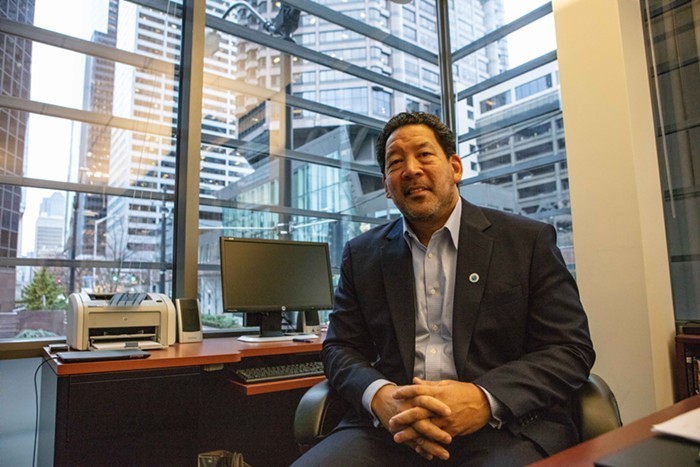For growers, harvest can be the most anticipated and the most dreaded time of the year. On one hand, it means they've successfully raised their crop despite mold, mildew, pests, and other hazards. On the other hand, it's one of the most labor-intensive parts of the growing process, involving weeks of drying, trimming, curing, and packaging.
Last week, I drove out to Quincy Green in Eastern Washington to watch growers harvest their crop of cannabis—towering pot plants that they lovingly refer to as "the ladies" because, well, they're all female.
Female pot plants, when separated from male plants and subjected to the right conditions—most importantly, exposure to darkness for 12-hour stretches—do not produce seeds but instead grow large resinous colas, or buds. That's the part that gets smoked (or ingested). When these colas are at their densest, they're ready to be harvested.
Quincy Green head grower Steffen Kightlinger showed me the farm's state-of-the-art "SmartHouse," a digitally controlled greenhouse that has all the tight environmental controls of an indoor grow but takes advantage of the free energy from the sun. The greenhouse is packed tightly with three rows of plants, representing a myriad of strains. The genetic diversity in the room is obvious even to a layperson—it's a patchwork quilt of colors: many shades of green, rich ochre and reds, deep purples, and pale yellows.
We selected a reddish NY Diesel plant, which was strung up like a marionette to keep its dense colas from drooping over and snapping their supporting stems. Mark Olson, the patriarch of the family-owned farm, took a heavy-duty garden lopper and sheared off the main stem. Kightlinger slung the bounty over his shoulder and deposited it in a waiting wagon, where it was hauled off to the processing building.
Olson's daughter, Annalise, acts as the farm's production manager, and she walked me through the complicated process of drying, curing, and trimming. First the plants must be weighed in order to log their "wet weight." Then they're hang-dried for about two weeks. When lightly bent branches snap instead of yield, they're ready to be broken down, lightly manicured, and evenly deposited into separate tubs for curing—a process akin to barrel-aging for wine.
Curing is an interesting and often overlooked part of the harvest process, and it can be what separates schwag from top-shelf product. Smoking uncured or improperly cured pot is not unlike drinking wine straight from the fermenter. As Cannabis.info explains, "Quickly-dried bud can taste harsh and have low potency. We've all been there: You buy a bag of weed that smells good and feels dry on the outside, but when you break the bud open it is still moist on the inside. The smoke is harsh and can taste a little like cut grass; this taste is the chlorophyll still present in the cells of the plant." Sadly, many growers rush their pot to market.
Curing takes another week or two, but can also go on for years. Although curing methods are hotly debated, it generally involves putting the pot into airtight Rubbermaid containers and periodically "burping" them to release moisture.
After the plant is cured, the sections are weighed again to determine their "dry weight" in order to satisfy the state's worry that nothing besides moisture content has disappeared. At this point, the plant gets its final trim. The trim is, like curing, something that elicits plenty of debate. The idea is to remove protruding leaves and exposed stems, ensuring that nothing but the dense "nug" of flower remains. However, certain connoisseurs I spoke with suggested that trimmers are often overzealous. Jess Henson, a former buyer at Higher Leaf in Kirkland, warned against the "California buzz cut," in which a bud is snipped barren.
Kightlinger prefers a bushier trim, noting that the "sugar leaves"—the small fan leaves interspersed in the plant's colas—have plenty of THC-laden trichomes on them, resembling a light dusting of sugar. Snip them, he says, and you're losing out not just on the visual appeal of the end product but also a little bit of potency. My uncle, an old-school pot grower from Hawaii, put it a little more laconically: "Bushier is better."
Everyone I asked agreed that, while hand trimming is a painstaking process, it beats the heck out of machine trimming. Kightlinger and Olson said that, in their experience, machine-trimmed pot was always either too leafy or too closely shorn.
Once trimmed, Quincy Green's bud is stored in nitrogen-sealed containers to await packaging. A four-gram sample is taken from each five-pound lot and sent to Steep Hill Labs, where it's tested for THC, CBD, THCA (tetrahydrocannabinolic acid), and total cannabinoids content.
When the samples return, the pot is carefully weighed again—packages must be within .01 gram of their labeled weight—put into Quincy Green's signature compostable packaging, and labeled with the testing information and bar code corresponding to its particular lot. After a 24-hour quarantine, it's loaded on a truck and shipped off to a retailer, where the journey from pot to bowl can, at long last, be completed. ![]()



















